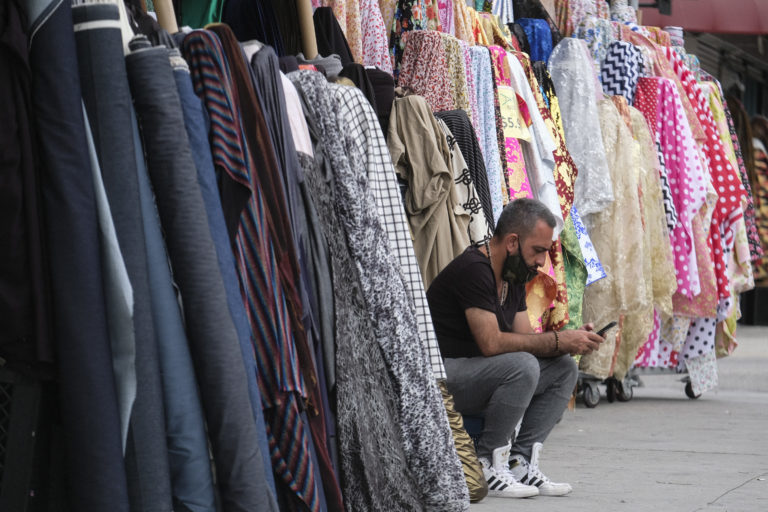
In Los Angeles County alone, 109,410 creative economy employees lost their jobs between February and December 2020, according to Otis College of Art and Design’s annual 2021 report on the creative economy.
The report looked at job losses for self-employed and payroll workers in five sectors: fine and performing arts, entertainment and digital media, creative goods and products, fashion, and architecture and related services.
L.A. County has long been a powerhouse of the creative economy. Of the 1.1 million creative economy jobs in California in 2018, 587,500 were based in L.A. County.
L.A. County Employment Share by Creative Sector |
|
| Entertainment and Digital Media | 66% |
| Fashion | 17% |
| Creative Goods and Product | 9% |
| Architecture and Related Services | 4% |
| Fine and Performing Arts | 4% |
| Source: Otis College of Art and Design | |
The entertainment and digital media sector — which includes film, publishing and emerging digital media — made up 66% of L.A. County’s creative economy employment in 2019. Fashion comprised 17%, while creative goods and products made up 9%. Fine and performing arts and architecture and creative services accounted for 4% each.
“It’s crucial that when we think of the recovery, we also put the creative economy into the frontline because it really is a backbone industry for the California economy,” said Mazen Bou Zeineddine, project lead for the report and manager for economic, fiscal and social impact analysis at Beacon Economics.
Growth stalls out
Growth stalls out
Between 2009 and 2018, total creative industry payroll positions increased 13.4% in L.A. County, adding 69,200 jobs during that period. Sectors that saw the highest gains were fine arts and performing arts, architecture and related services, and entertainment and digital media.
The fine arts and performing arts category — which includes dance and theater companies, museums, artists and more — saw employment jump 41.2% during that period.
Architecture saw 25.4% growth in employment during those years, and entertainment and digital media saw a 20.5% increase.
But some industries saw little to no growth during the same period. Creative products saw a slight uptick in employment of 1.9%, while employment in the fashion sector fell 14.5%.
Share of Pandemic Job Losses by Creative Sector |
|
| Entertainment and Digital Media | 82.7% |
| Fashion | 11.2% |
| Fine and Performing Arts | 4.8% |
| Architecture and Related Services | 1.1% |
| Creative Goods and Product | 0.2% |
| Source: Otis College of Art and Design | |
The entertainment and digital media sector saw high growth, but also suffered the steepest fall when the pandemic hit. The sector accounted for 82.7% of the total job losses in L.A. County’s creative economy, with more than 90,000 workers losing their jobs between February and December 2020.
“For Los Angeles, the largest (decliner) was entertainment and digital media, which is actually unsurprising when you think of the context,” Zeineddine said. “Los Angeles is the hub for entertainment and digital media not only in California, but across the United States.”
Fashion was the
Some sectors saw relatively low losses in employment. Fine and performing arts job losses made up 4.8% of the total job losses while architecture comprised 1.1%, and creative goods and products job losses were 0.2%.
Average Annual Wages by Creative Sector |
|
| Entertainment and Digital Media | $139,900 |
| Architecture and Related Services | $100,600 |
| Fine and Performing Arts | $89,511 |
| Creative Goods and Product | $66,331 |
| Fashion | $64,902 |
| Source: Otis College of Art and Design | |
Helping hands
Helping hands
“There’s no doubt that the pandemice has taken a significant toll on L.A.’s arts sector, the CCF said in a statement. “The L.A. Arts Recovery Fund will be part of the solution.”
In order for creative industries to recover from the pandemic’s economic blow, Zeineddine said it’s important that policymakers put creative economy jobs at the forefront. The Otis report recommended actions such as creating uniform guidelines for reopening performances and temporary fee waivers and permitting flexibility for special events.
Zeineddine said that increasing the availability and affordability of creative spaces, such as soundstages where occupancy has stayed above 90% since 2016, would help independent and smaller producers get back on their feet.
“It’s really important for policymakers to address that, for a place like Los Angeles, where creative spaces are in such high demand and there’s so little of it, creating policies that allow us to develop more creative space to accommodate the talent that we have,” he said
